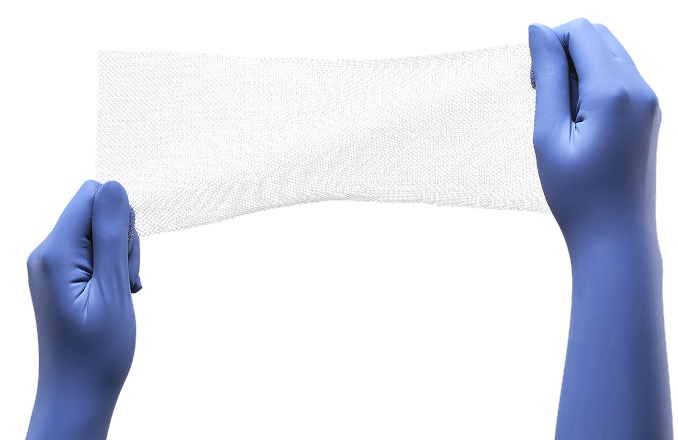OPEN UP TO
RESORBABLE REINFORCEMENT
DuraSorb® Monofilament Mesh is a 100% bioresorbable scaffold engineered from polydioxanone (PDO) material to address limitations in current soft tissue reinforcement options, support natural healing, and minimize risk of infection.¹-⁷*
†Sample provided is non-clinical and for evaluation only. Not intended for patient use.
*Performance from pre-clinical investigations. Pre-clinical results may not be indicative of clinical results.
Trusted Technology in Full Bloom
Building on 40 years of clinically proven polydioxanone (PDO) performance. DuraSorb provides surgeons with a versatile option for soft tissue reinforcement. 7-8*
DuraSorb is a macroporous, monofilament scaffold that exhibits full resorption and
allows for natural remodeling within 12 months:¹*‡
‡Not real tissue. Visual representation only.
*Performance from pre-clinical investigations. Pre-clinical results may not be indicative of clinical results.
Discover the full potential of DuraSorb with our in-depth resources. Access detailed pre-clinical research, analyze estimated trends, and review projected performance metrics to deepen your understanding of how DuraSorb offers surgeons a versatile solution for soft tissue reinforcement.*
12-Month Strength Profile
Examine estimated trends in residual implant strength‡ and tissue strength over 52 weeks.*
Pre-clinical Data
Review a biomechanical and histologic evaluation of DuraSorb mesh in a porcine model of abdominal wall repair.*
Clinical Information
Complete our medical information request form to connect with our Medical Affairs team and receive detailed insights.*
¶Residual implant strength decline reflective of device resorption.
*Performance from pre-clinical investigations. Pre-clinical results may not be indicative of clinical results.
See the beauty of balanced performance for yourself. Request your complimentary non-clinical sample by completing this brief form.§
§Please note that samples are limited to industry professionals. Your information helps us ensure you receive the most relevant materials for your practice.

INDICATIONS FOR USE
DuraSorb® Monofilament Mesh is intended for use in reinforcement of soft tissue where weakness exists. DuraSorb is intended for use by licensed medical professionals.
CONTRAINDICATIONS
- DuraSorb Monofilament Mesh must always be separated from the abdominal cavity by peritoneum.
- Not for use following planned intra-operative or accidental opening of the gastrointestinal tract. Use in these cases may result in contamination of the mesh, which may lead to infection.
- Not suitable for reconstruction of cardiovascular defects.
PRECAUTIONS
- The device is limited to use by physicians who are trained to perform the required surgical procedure.
- DuraSorb has not been studied for use in:
- The repair of direct inguinal hernias
- Intraperitoneal Use
- The safety and effectiveness of DuraSorb in breast reconstruction has not been determined by the FDA.
- DuraSorb is sterile if the foil pouch is unopened and undamaged.
- Do not use after the expiration date.
- The mesh should be large enough to extend beyond the margin of the defect
- Improper selection, placement, positioning, and fixation of DuraSorb may cause unintended results.
- The safety and effectiveness of DuraSorb has been established with permanent and absorbable sutures, but has not been established with other fixation methods.
- For single use only. Do not re-sterilize.
WARNINGS
- Do not use on contaminated and/or infected wounds.
- DuraSorb is fully resorbable and should not be used in repairs where permanent support from the mesh is required.
- The safety and effectiveness of DuraSorb has not been established for urogynecological use. Refer to safety communications from the FDA and from UK’s National Institute for Health and Clinical Excellence (NICE) for guidance.
- The safety and effectiveness of DuraSorb Monofilament Mesh has not been established for use in tendon repair.
ADVERSE REACTIONS
Possible adverse reactions with DuraSorb are those typically associated with any implantable mesh, including, but not limited to, infection, re- operation for mesh removal, inflammation, extrusion, erosion, adhesion, fistula formation, seroma formation, hematoma, mechanical mesh failure, dehiscence, necrosis, and recurrence of the hernia or tissue defect.
References: 1. Mlodinow AS, Yerneni K, Hasse ME, et al. Evaluation of a novel absorbable mesh in a porcine model of abdominal wall repair. Plast Reconstr Surg Glob Open. 2021;9(5):e3549. 2. Engelsman AF, van Dam GM, van der Mei HC, Busscher HJ, Ploeg RJ. In vivo evaluation of bacterial infection involving morphologically different surgical meshes. Ann Surg. 2010;251(1):133-137. 3. Klinge U, Junge K, Spellerberg B, Piroth C, Klosterhalfen B, Schumpelik V. Do multifilament alloplastic meshes increase the infection rate? Analysis of the polymeric surface, the bacteria adherence, and the in vivo consequences in a rat model. J Biomed Mater Res. 2002;63(6):765-771. 4. Klinge U, Klosterhalfen B, Birkenhauer V, Junge K, Conze J, Schumpelick V. Impact of polymer pore size on the interface scar formation in a rat model. J Surg Res. 2002;103(2):208-214. 5. Sanders D, Lambie J, Bond P, Moate R, Steer JA. An in vitro study assessing the effect of mesh morphology and suture fixation on bacterial adherence. Hernia. 2013;17(6):779-789. 6. Ray JA, Doddi N, Regula D, Williams JA, Melveger A. Polydioxanone (PDS), a novel monofilament synthetic absorbable suture. Surg Gynecol Obstet. 1981;153(4):497-507. 7. Martins JA, Lach AA, Morris HL, Carr AJ, Mouthuy PA. Polydioxanone implants: a systematic review on safety and performance in patients. J Biomater Appl. 2019;34(7):902-916. 8. DOF. SIA DuraSorb Registry Study Investigator Satisfaction Survey.

DuraSorb and the Integra logo are registered trademarks of Integra LifeSciences Corporation or its subsidiaries in the United States and/or other countries.
© 2025 Integra LifeSciences Corporation. All rights reserved. 5748971-1-EN